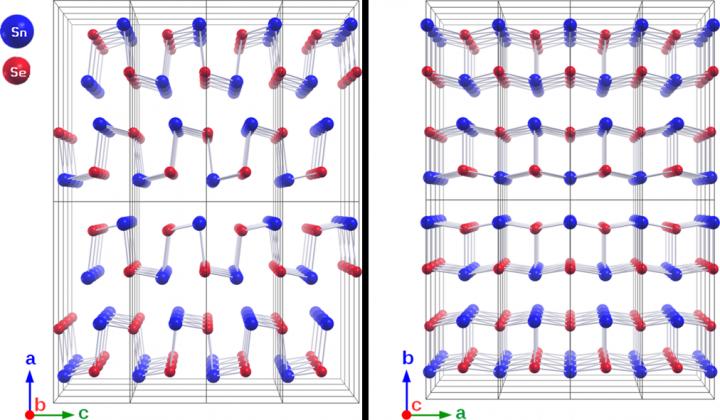High-efficiency thermoelectric materials: New insights into tin selenide

SnSe is a highly layered orthorhombic structure. SnSe undergoes a phase transition of second order at 500°C with an increase of the crystal symmetry from space group Pnma (left) to Cmcm (right). Credit: HZB
However, the thermoelectric effect in most materials is extremely small. This is because to achieve a large thermoelectric effect, heat conduction must be poor, whereas electrical conductivity must be high.
However, heat conduction and electrical conductivity are almost always closely associated.
For this reason, the search for thermoelectric materials concentrates on compounds with special crystalline structures such as bismuth telluride (Bi2Te3).
Bismuth telluride is one of the best thermoelectric materials known to date. However, both bismuth and tellurium are rare elements, which limit their large-scale use. So the search continues for suitable thermoelectric materials among more abundant non-toxic elements.
Six years ago, a research team from the USA discovered that tin selenide above 500 degrees Celsius can convert about 20 per cent of heat into electrical energy. This is an enormous efficiency and considerably exceeds the value for bismuth telluride. In addition, tin and selenium are abundant.
This extremely large thermoelectric effect is related to a phase transition or re-arrangement of the crystal structure of tin selenide. The crystal structure of tin selenide consists of many layers, similar to filo or puff pastry.
At 500 degrees Celsius, the layers start to self-organise and the heat conduction decreases, while charge carriers remain mobile. The efficiency of the thermoelectric effect in this crystallographic orientation of tin selenide has not been exceeded by any other material to date.
High pressure works
An international team led by Dr. Ulrich Schade at the HZB has now comprehensively examined samples of tin selenide with the aid of infrared spectroscopy at BESSY II and hard X-rays at PETRA IV. The measurements show that the desired crystal structure is produced by either high temperature at normal pressure or high pressure (above 10 GPa) at room temperature.
The electronic properties also change from semiconducting to semi-metallic in the high-temperature structure. This fits the predictions from theoretical calculations of the model and also from band-structure calculations.
“We are able to explain with our data and our calculations why tin selenide is such an outstanding thermoelectric material over a wide temperature and pressure range”, says Schade.
Further development work will be necessary to guarantee long-term stability, for example, before thermoelectrical devices based on tin selenide really come onto the market, though. Then tin selenide might become an economical and readily available alternative to bismuth telluride.
Media Contact
All latest news from the category: Materials Sciences
Materials management deals with the research, development, manufacturing and processing of raw and industrial materials. Key aspects here are biological and medical issues, which play an increasingly important role in this field.
innovations-report offers in-depth articles related to the development and application of materials and the structure and properties of new materials.
Newest articles

A ‘language’ for ML models to predict nanopore properties
A large number of 2D materials like graphene can have nanopores – small holes formed by missing atoms through which foreign substances can pass. The properties of these nanopores dictate many…

Clinically validated, wearable ultrasound patch
… for continuous blood pressure monitoring. A team of researchers at the University of California San Diego has developed a new and improved wearable ultrasound patch for continuous and noninvasive…

A new puzzle piece for string theory research
Dr. Ksenia Fedosova from the Cluster of Excellence Mathematics Münster, along with an international research team, has proven a conjecture in string theory that physicists had proposed regarding certain equations….



